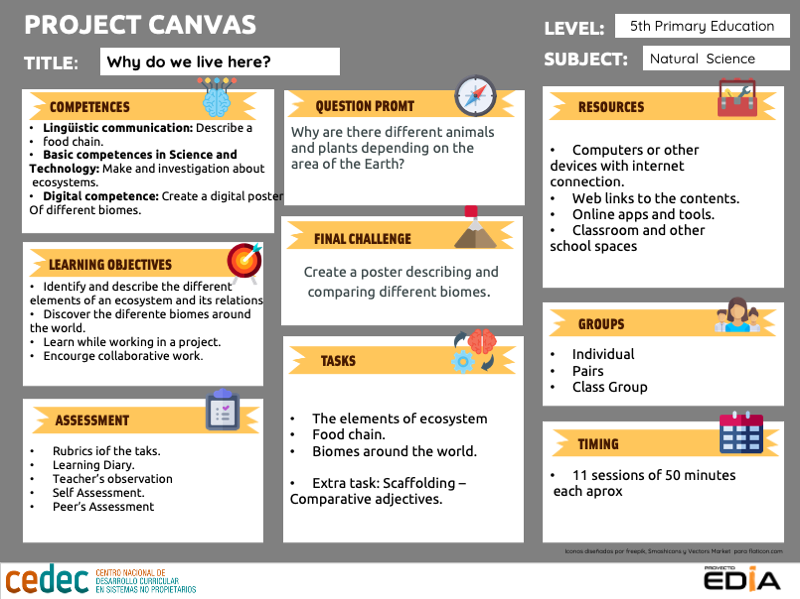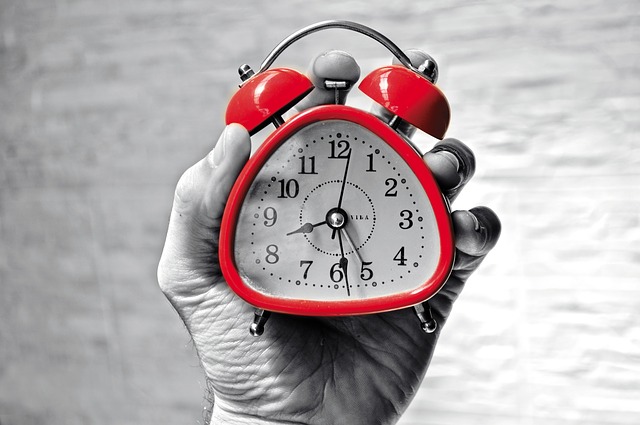- Didactic guidelines -
General guidelines for teachers
This project is made up of four different missions whose main topic is the ecosystems and the relation among their elements. There are activities to do individually or in pairs.

This project is part of a set of some projects designed to cover all the learning standards of the Natural Science curriculum of Primary Education are published at the BOE (March 1st 2014), pages 17 - 21. With this project you will be able to let your students be autonomous learners and guide them through their learning.
There are activities which involve both individual work, collaborative pair work.
We strongly recommend to work with them through daily aims to get to the end of the project and accomplish each challenge successfully. This means at the beginning of each lesson you should take five minutes to check where your students are and to tell them where you would like them to get at the end of the mission.
For example: 'At the end of the mission each student will have had to finish the presentation, which will be checked by the teacher'.
Each project is student-centred and has several areas of interest:
- In each project, students have to accomplish a task, in order to learn by doing.
- There is also a challenge in each task, where they have to collaboratively design a product. They are expected to actively work with information and communication technologies. There should be a portfolio to show all their knowledge along this set of tasks.
- Students also have to complete a learning diary, using a sharing document using the different tips we offer to the students at the end of each mission.
- We strongly recommend student to have a personal portfolio, where they have to reflect on the different contents they are working on, they have to upload the different audios and videos they produce, and they can share. This could be done by a blog, shared document or board.
To sum it up, they are going to work on all the contents of the syllabus of their level with a project-based learning orientation.
Assessing
For assessment, both you as a teacher and your students are expected to use the the following rubrics:
- Rubric to assess a glossary
- Rubric to assess a video
- Rubric to assess a digital poster
- Rubric to assess a digital presentation
This project is designed to be assessed following this pattern:
- The Teacher will evaluate the portfolio with all the products produced during the project following the rubrics. It will be 40% of the final score.
- The partners will carry out peer assessment the work and grade about how their teamwork has worked. It will be 20% of the final score . The students can generate the different criteria or items to be assessed.
- Students will self-assess the final task using the rubric. It will be 20% of the final score.
The final score will also include a 20% for the teacher to evaluate how the students have been involved in the project or tackled the different activities.
At the end of the project the student will have been able to:
- Identify the different elements you can find in an ecosystem.
- Discover which are the different relations among the living things in an ecosystem.
- Create a food chain with all its members.
- Recognise the different biomes you can find into the Earth.
- Identify some invasive species we have in Spain and the risk it could have for their ecosystems.
Curricular References
- Contents
-
Contenidos siguiendo el Curriculo del BOE (March 1st 2014), pages 17 - 21.
Bloque 1. Iniciación a la actividad científica.
- Iniciación a la actividad científica. Aproximación experimental a algunas cuestiones.
- Utilización de diferentes fuentes de información (directas, libros).
- Lectura de textos propios del área.
- Utilización de las tecnologías de la información y comunicación para buscar y seleccionar información, simular procesos y presentar conclusiones.
- Trabajo individual y en grupo.
- Técnicas de estudio y trabajo. Desarrollo de hábitos de trabajo. Esfuerzo y responsabilidad.
- Planificación de proyectos y presentación de informes.
- Realización de proyectos.
Bloque 3: Seres vivos.
- Las relaciones entre los seres vivos. Cadenas alimentarías. Poblaciones, Comunidades y ecosistemas.
- Características y componentes de un ecosistema. Ecosistemas, pradera, charca, bosque, litoral y ciudad y los seres vivos.
- La biosfera, diferentes hábitats de los seres vivos.
- Learning standards
-
Estándares de aprendizaje siguiendo el Curriculo del BOE (March 1st 2014), pages 17 - 21.
Bloque 1. Iniciación a la actividad científica.
1.1. Busca, selecciona y organiza información concreta y relevante, la analiza, obtiene conclusiones, comunica su experiencia, reflexiona acerca del proceso seguido y lo comunica oralmente y por escrito.
1.2. Utiliza medios propios de la observación.
1.3. Consulta y utiliza documentos escritos, imágenes y gráficos.
1.4. Desarrolla estrategias adecuadas para acceder a la información de los textos de carácter científico.
2.1. Manifiesta autonomía en la planificación y ejecución de acciones y tareas y tiene iniciativa en la toma de decisiones.
3.1. Utiliza, de manera adecuada, el vocabulario correspondiente a cada uno de los bloques de contenidos.
3.2. Expone oralmente de forma clara y ordenada contenidos relacionados con el área manifestando la compresión de textos orales y/o escritos.
4.1. Usa de forma autónoma el tratamiento de textos (ajuste de página, inserción de ilustraciones o notas, etc.).
4.2. Hace un uso adecuado de las tecnologías de la información y la comunicación como recurso de ocio.
4.3. Conoce y utiliza las medidas de protección y seguridad personal que debe utilizar en el uso de las tecnologías de la información y la comunicación.
4.4. Presenta los trabajos de manera ordenada, clara y limpia, en soporte papel y digital.
4.5. Utiliza estrategias para realizar trabajos de forma individual y en equipo, mostrando habilidades para la resolución pacífica de conflictos.
4.6. Conoce y respeta las normas de uso y de seguridad de los instrumentos y de los materiales de trabajo.
5.1. Realiza experiencias sencillas y pequeñas investigaciones: planteando problemas, enunciando hipótesis, seleccionando el material necesario, realizando, extrayendo conclusiones, y comunicando los resultados.
5.2. Realiza un proyecto, trabajando de forma individual o en equipo y presenta un informe, utilizando soporte papel y/o digital, recogiendo información de diferentes fuentes (directas, libros, Internet), con diferentes medios y comunicando de forma oral la experiencia realizada, apoyándose en imágenes y textos escritos.Bloque 3. Seres vivos.
3.1. Identifica y explica las relaciones entre los seres vivos. Cadenas alimentarias. Poblaciones, comunidades y ecosistemas.
3.2. Identifica y explica algunas de las causas de la extinción de especies.
3.3. Observa e identifica las principales características y componentes de un ecosistema.
3.4. Reconoce y explica algunos ecosistemas: pradera, charca, bosque, litoral y ciudad, y los seres vivos que en ellos habitan.
- Key competences
-
At the end of the project the student will have worked and developed these competences:
- Lingüistic communication:
- Student will be able to compare diferent kinds of biomes.
- Student will be able to describe a food chain.
- Maths competences and basic competences in Science and Technology:
- Students will be able to make an investigation about ecosystems.
- Digital competence:
- Students will be able to create a products using an ICT Tool. (glossary, video, diigital poster and digital presentation)
- Students will be able to use different links to investigate in the net.
- Learn to learn competence:
- Students will be able to reflex about their learning process everyday by using a tool such a Learning Diary.
- Social competences:
- Students will be able to work in group and asses their working along the project.
- Students will be able to make group decisions to achieve the final product.
- Entrepreneurship competences:
- Students will be able to work automously by following the steps of the investigation.
- Cultural competences:
- Students will be able to learn about the different biomes around the world and their characteristics.
- Lingüistic communication:
Timing
This project implies the use of about ten or eleven fifty-minute lessons. The timing is, obviously, approximate. It will depend on the learning pace of the students and on their interests and the activities done in class.
The ten - eleven lessons could be used according to this guide:
- The first lesson is for the Breaking the ice.
- Two of the lessons will be to discover the different elements of the ecosystem.
- Two lesson will be use to learn about the food chain.
- Another two lessons will be to investigate and compare different biomes around the world.
- There is couple extra lesson about COMPARATIVE ADJECTIVES for scaffolding the understanding of the grammar the students will need to compare the biomes
- And the last lesson will be a good opportunity to assess students and do the collaborative assessment. And also it would be great to evaluate the project itself.
Resources
ICT resources/apps/tools
For this project you will need the following links to different sites:
- Explore 8 types of energy for kids by Smartclass 4Kids
- Peekaboo Kidz. Energy
- Energy by Kids Britannica
- What is renewable and non renewable energy? by BBC Bitesize
- Smile and Learn. Types of energy for kids - Renewable and non renewable sources of energy
- Armagan Citak. Sports, actions and Can/Can't
- Learn English - British Council: Modals Can and Can't
- Agenda Web: Can exercises.
- Live Worksheets: Cartoon Characters - Action Verbs & Can - Can't
- The Global Goals. The World largest lesson
- What can you do?. SDG 11 Sustainable Cities
Tools:
How to
Licensed under the Creative Commons Attribution Share Alike License 4.0
